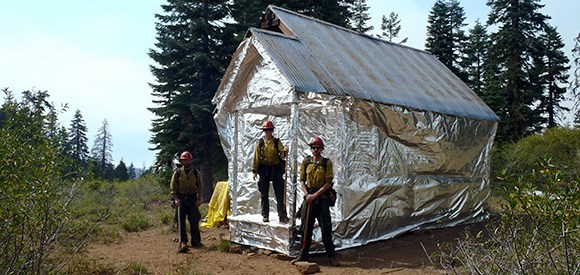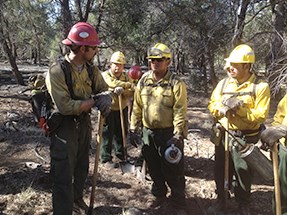Last updated: January 19, 2017
Article
Wildland Fire Module Provides Nationwide Response Support

The Saguaro Wildland Fire Module (WFM) participated in more than 20 projects/incidents within Arizona, New Mexico, Texas, Utah, and California in 2013. Assignments included a diversity of planned and unplanned fire events, mechanical fuel treatments, and more than 400 wildfire defensible space structure assessments. The Saguaro WFM consistently demonstrated versatility and leadership throughout the year. This included their willingness to share their training and expertise in June, when the module led a crew of Type 2 firefighters from the San Carlos-Apache Nation on the Creek fire on the San Carlos Agency, Arizona.

Additional interagency assignments included wildfire and planned fire support, which included the Lesna, Washington, Alamo, Sardina, Cantina, and Milepost 8 wildfires; the Lower Soldier and Bigelow prescribed fires on the Coronado National Forest, Arizona; the Pisinemo fire on the Tohono O’Odham Nation, Arizona; the Grizzly and Corral fires on the Six Rivers National Forest, California; and the Butler fire on the Klamath National Forest, California.
The primary mission of a wildland fire module is to provide an innovative, safe, highly mobile, logistically independent, and versatile fire module with a primary commitment to maintain fire’s role as a natural ecological process for wildland fire management and incident operations.
Wildland fire modules provide a unique skill of high operational self-sufficiency. They have the capability to operate in any location with little to no need for additional supplies or support from local fire management or incident management teams. The modules carry backcountry camping equipment and have purchasing authority to sustain the crew for up to seven days at a time. They specialize in fire intelligence gathering such as perimeter mapping, line placement, and identification of critical resource values, control points, management action points, and safety zones; structure protection triage, planning, and implementation actions; and monitoring, recording, and validating weather, fuel conditions, first- and second-order fire effects, fire behavior, and burn severity. In addition, wildland fire modules may be used for initial attack operations and to fill ready reserve duties to assist local and national fire management needs.
Contact: Jason Thivener, wildland fire module leader
Email: e-mail us
Phone: (520) 733-5167
